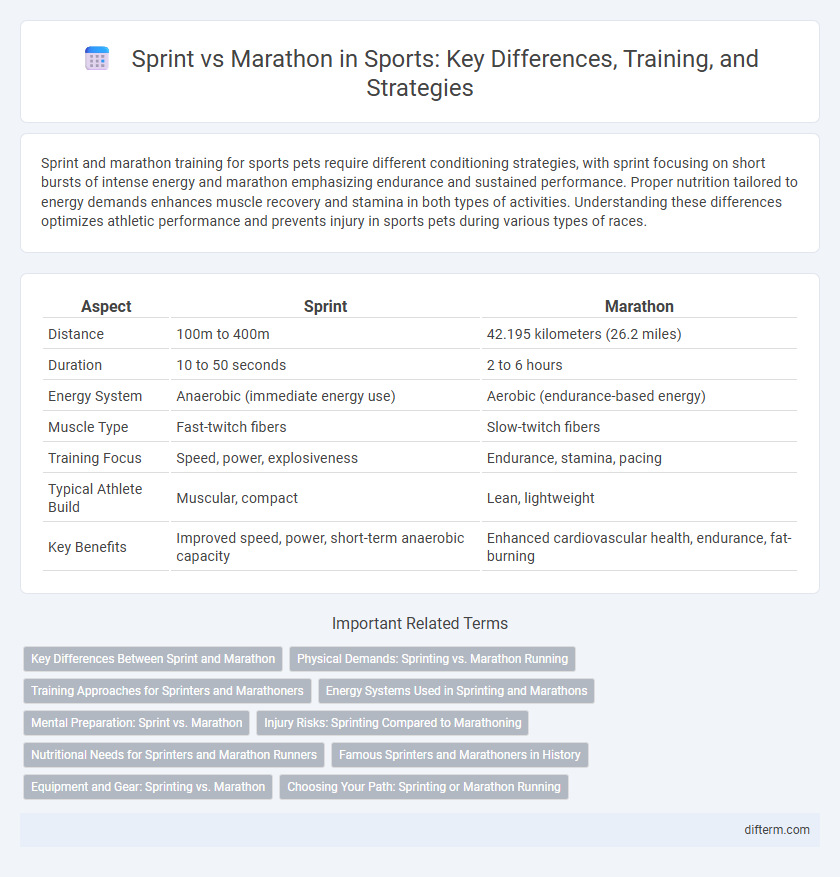Sprint and marathon training for sports pets require different conditioning strategies, with sprint focusing on short bursts of intense energy and marathon emphasizing endurance and sustained performance. Proper nutrition tailored to energy demands enhances muscle recovery and stamina in both types of activities. Understanding these differences optimizes athletic performance and prevents injury in sports pets during various types of races.
Table of Comparison
| Aspect | Sprint | Marathon |
|---|---|---|
| Distance | 100m to 400m | 42.195 kilometers (26.2 miles) |
| Duration | 10 to 50 seconds | 2 to 6 hours |
| Energy System | Anaerobic (immediate energy use) | Aerobic (endurance-based energy) |
| Muscle Type | Fast-twitch fibers | Slow-twitch fibers |
| Training Focus | Speed, power, explosiveness | Endurance, stamina, pacing |
| Typical Athlete Build | Muscular, compact | Lean, lightweight |
| Key Benefits | Improved speed, power, short-term anaerobic capacity | Enhanced cardiovascular health, endurance, fat-burning |
Key Differences Between Sprint and Marathon
Sprint events, typically ranging from 100 to 400 meters, emphasize explosive speed, anaerobic energy systems, and fast-twitch muscle fibers, while marathons cover 42.195 kilometers, relying heavily on aerobic endurance, slow-twitch muscle fibers, and efficient energy metabolism. Training for sprints focuses on short, high-intensity bursts with strength and power development, whereas marathon training prioritizes long-distance stamina, cardiovascular conditioning, and energy conservation. Recovery time, muscle fatigue, and metabolic demands vary significantly, making the physiological and strategic approaches to sprinting and marathon running distinct.
Physical Demands: Sprinting vs. Marathon Running
Sprinting demands explosive power, fast-twitch muscle fiber activation, and anaerobic energy systems to sustain short, intense bursts of speed. Marathon running relies heavily on aerobic endurance, efficient oxygen utilization, and slow-twitch muscle fibers to maintain a steady pace over extended distances. The contrasting physiological requirements highlight sprinting's emphasis on maximum acceleration and strength, whereas marathon running prioritizes stamina and metabolic efficiency.
Training Approaches for Sprinters and Marathoners
Sprinters emphasize high-intensity interval training, explosive power drills, and anaerobic conditioning to maximize speed and fast-twitch muscle fiber recruitment. Marathoners focus on long-duration endurance runs, aerobic base building, and energy management strategies to enhance cardiovascular efficiency and muscular fatigue resistance. Both training approaches tailor nutrition and recovery protocols specifically to their intensity and duration demands for optimal performance.
Energy Systems Used in Sprinting and Marathons
Sprinting primarily utilizes the anaerobic energy system, relying on the phosphagen and glycolytic pathways to generate rapid bursts of energy without oxygen. Marathons depend on the aerobic energy system, efficiently using oxygen to metabolize carbohydrates and fats for sustained energy over long distances. Understanding these distinct energy mechanisms helps optimize training and performance for each event.
Mental Preparation: Sprint vs. Marathon
Mental preparation for sprints involves intense focus on explosive power and rapid decision-making under pressure, requiring athletes to harness adrenaline and maintain peak concentration for short bursts. Marathon runners prioritize sustained mental endurance, cultivating strategies for pacing, resilience against fatigue, and managing psychological stress over extended periods. Cognitive training in both disciplines enhances performance, yet sprinters emphasize acute alertness while marathoners develop long-term perseverance tactics.
Injury Risks: Sprinting Compared to Marathoning
Sprinting poses a higher risk of acute injuries such as hamstring strains, muscle tears, and joint sprains due to explosive movements and intense force exerted in short bursts. Marathoning, while involving lower impact per stride, carries a greater risk of overuse injuries including stress fractures, tendonitis, and chronic joint pain as a result of prolonged repetitive motion and endurance strain. Understanding the distinct injury profiles is critical for athletes in tailoring training, recovery, and injury prevention strategies specific to sprinting or marathon running disciplines.
Nutritional Needs for Sprinters and Marathon Runners
Sprinters require a diet rich in protein and carbohydrates to support explosive power and muscle repair, emphasizing fast-digesting carbs and lean proteins for immediate energy and recovery. Marathon runners depend on high carbohydrate intake for sustained energy, with an emphasis on complex carbs, electrolyte balance, and hydration to maintain endurance and prevent fatigue during prolonged activity. Both athletes must tailor nutrient timing and hydration strategies to optimize performance specific to their event demands.
Famous Sprinters and Marathoners in History
Usain Bolt, widely regarded as the fastest sprinter in history, holds world records in the 100m and 200m events, while marathon legends like Eliud Kipchoge have broken the two-hour barrier in official marathon races. Sprinters typically excel in explosive speed and anaerobic power, whereas marathoners demonstrate exceptional endurance and aerobic capacity over 42.195 kilometers. Historic performances by athletes such as Jesse Owens in sprinting and Kathrine Switzer in marathon running have shaped the legacy and evolution of their respective sports.
Equipment and Gear: Sprinting vs. Marathon
Sprinting requires lightweight, aerodynamic shoes with stiff spikes designed for explosive power and maximum ground grip, while marathon runners prioritize cushioned, durable footwear that offers long-term comfort and shock absorption over extended distances. Sprint apparel often includes tight-fitting, breathable fabrics to reduce drag and enhance speed, whereas marathon gear focuses on moisture-wicking, temperature-regulating materials to sustain performance and prevent overheating. Both sports utilize specialized gear tailored to their unique demands, significantly impacting athletes' efficiency and injury prevention.
Choosing Your Path: Sprinting or Marathon Running
Choosing between sprinting and marathon running depends on your physiological strengths and training preferences. Sprinters emphasize explosive power, fast-twitch muscle fibers, and short bursts of maximum effort, while marathon runners cultivate endurance, aerobic capacity, and energy efficiency over long distances. Understanding your body's metabolic profile and recovery ability helps optimize performance in either 100-meter dashes or 42.195-kilometer races.
sprint vs marathon Infographic

 difterm.com
difterm.com